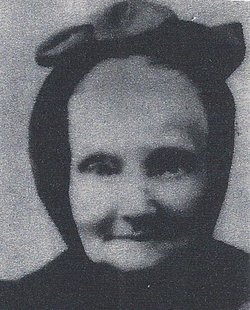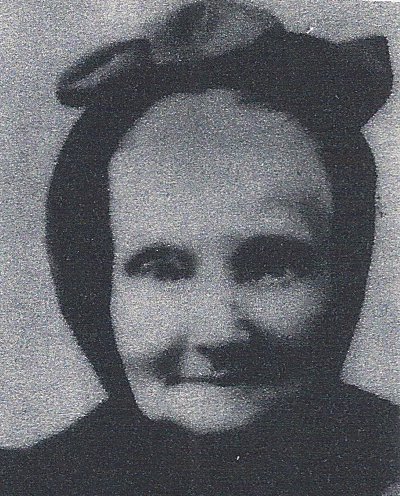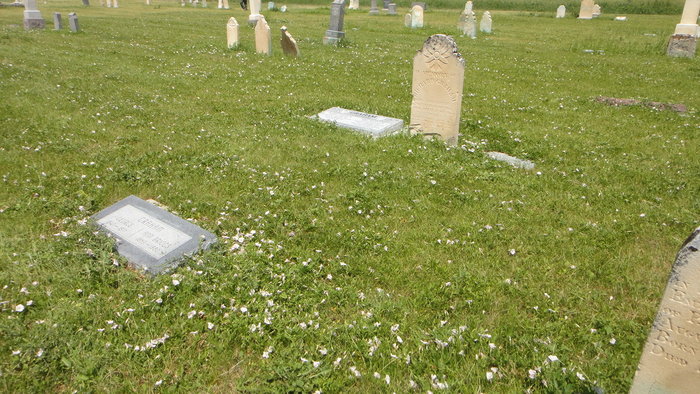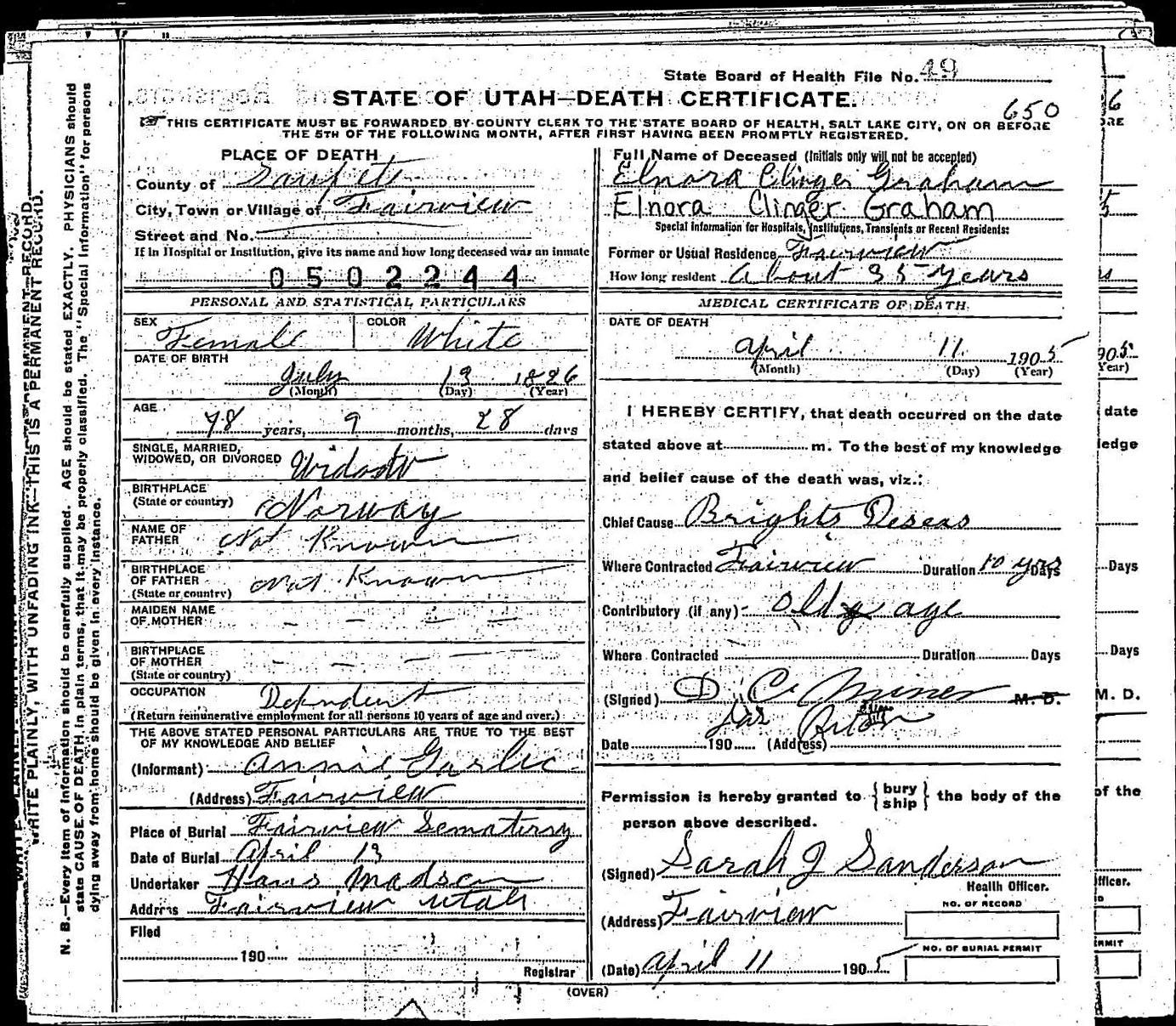Contributed By TurpinBrittanyNicole1 · 2014-03-02 19:41:44 GMT+0000 (UTC)
Helene Eleanore Klinger was born July 13, 1826 in Randers Denmark. She was the daughter of Frantz Gotlib Klinger and Ane Christensen. She married Christen Pedersen, who was a carpenter by trade. Their children were: Alfred Christen, Ludwig Johan, Adolf Adrian, Frederick Carl, Ezra, Ave Josepha, Johanna and Caroline. Four of these children died when they were quite young while they lived in Randers Denmark and Caroline was born just before Helene reached Utah.
In 1850 the Danish Government passed a law which allowed the missionaries of other churches to come into Denmark and teach their religion. The Church of Jesus Christ of Latter-Day Saints sent missionaries over there to preach the gospel. Several missions were established that year, the first was at Skagen, also at Allsborg and Copenhagen. However it was not until 1857 that the Aarhus mission was organized which included the city of Randers.
The Pedersen family heard of this church and attended some of the meetings out of curiosity. They soon became interested and were baptized October 1, 1861. They were told that President Brigham Young wanted all of the members of the church to go to America where he had established a home for the church in the land of Zion. The headquarters were in the Valley of the Great Salt Lake, which was located in the mountains of Western America. Helene was a very religious person and her belief in the teachings of this church grew stronger each day. She started making plans to go with the other Saints to Zion. However, her husband would not even consider leaving his home and going to a foreign country. Helene went on with the preparations for the journey, thinking that surely he would change his mind and go with her when he could see that she really intended to go.
It required a great deal of preparation for this long journey, there were many things she would liked to take which must be left behind. She could take only the bare necessities. Among the things she was required to provide for her family were 2 pairs of shoes, a warm jacket and their most sturdy clothes for each of them. The bedding must be such that would keep them warm during the cold winters in the mountains. She must furnish each with a tin dish, cup, plate, knife, fork, spoon and a tin vessel to hold three quarts of water. She would also need clothes for the new baby which she was expecting in late summer, hopefully this baby would be born in the land of Zion.
When the time came to leave Denmark, her husband had not changed his mind about going to America. So Helene, with her 3 children, Alfred, Carl and Ane went to the missions in Aarhus to begin their long journey. They joined many other Scandinavian converts in Copenhagen. They departed from Copenhagen on Friday May 1, 1863 and crossed the Baltic Sea to Kiel Germany. From Kiel they were taken by train to Altone Germany, then walked to Hamburg where they boarded a ferry which took them to England. They left at about midnight to cross the north sea. They landed at Grimsby and went by train to Liverpool. On Friday May 8th they sailed on the ship B.S. Kimball for America. There were 657 Saints on board, most of them were from the Scandinavian countries. Down between the decks it was quite dark and there was a little confusion until Helene found the small space which was allotted to her and her children. This was less than 14 square feet of deck space for herself and the same for Alfred, with half that amount for Carol and Ane. There were two bunks six feet long and eighteen inches wide and two smaller ones. This was to be their home for 39 days. In the center of the deck were two long tables, on each side of the tables long benches were secured to the floor.
Helene had to do this cooking for her own family, this was done in the ships galley. The stove was about ten feet square with space all around to stand and hold on to the pans so they would not slide off when the ship rocked. Helene was sea sick much of the time, so Alfred had to do a lot of the cooking. This was their weekly food allowance for adults, with half that amount for children:
1 lb wheaten flour
2 lbs rice
2 oz. tea
2-1/2 lbs. bread (not inferior to Navy Biscuits)
5 lbs. oatmeal
1/2 lb. sugar
2 oz salt
In addition, the saints were furnished by the Church for the voyage, 2-1/2 lbs sugar, 3 lbs of cheese and a pint of vinegar for each adult and half that amount for children under 14 years of age. 1 lb of beef or pork weekly for each adult could be taken as a substitute for 1 lb oatmeal. Each passenger was allowed 3 quarts of water daily. After a few days on this diet, they wished for some of the good food which had been plentiful in Denmark. Alfred never forgot those terrible biscuits. In order to preserve well they were made without shortening, resulting in a very hard unpalatable biscuit.
They assembled on deck each evening for singing and prayer. Church meeting were held on Sundays. After a long, rough voyage, they landed in New York on Monday June 15, it was good to be on land again. The Church leaders had made arrangements for a train to take the Saints on to St. Louis, however there was no passenger cars available when they arrived. Finally a train of cattle cars was found and they rode for two days in these cattle cars before they were able to transfer to a passenger train.
In St. Louis they were put aboard a river boat which would take them to Florence, Nebraska. They traveled up the Mississippi River for 19 miles, to where the Missouri River entered the Mississippi, here the boat turned up the Missouri River for the rest of the trip.
When the Saints and their baggage were loaded on the boat, the deck was only a few inches above the water. There was no high rail around it as there would have been on a regular passenger ship, just a two to six inch rail for ease in loading cargo. Carol, who was just nine years old was playing on deck with some other boys, when he and two others fell off the stern. They went down into the churning water and were not seen again. There was no chance to save them, the boat did not even stop, but continued on up the river. Helene thought her hears would break, she would never forget his cry of terror as he fell. She could not bear the thought of leaving his little body in that watery grave. She prayed that it would be washed ashore and someone would find him and give him a proper burial.
They rested at Florence Nebraska for a few days while waiting for the teams to arrive from Salt lake City to take them on the rest of their journey. Helene and her children were put in a company of 250 Saints under Captain John Frank Saunders. He had 50 wagons, 398 oxen, 5 horses, 4 guards and 5 teamsters. On Wednesday July 6th, they started out on the last and hardest part of their journey, the crossing of the plains.
Helene was expecting her baby in a few weeks and walking all day, every day was very tiring, however she was never heard to complain. She did her share of the work in camp each night before going to bed, and all too soon it was morning again with another long day of walking. Somewhere in the hills of Wyoming her little daughter was born, she gave her the name of Caroline. Now Helene could ride in one of the wagons, what a welcome relief. Riding in a freight wagon over rough roads was not very comfortable, still it was better than walking.
At last they reached the top of Big Mountain and Helene got her first view of the Great Salt Lake Valley. She put her arms around her children and cried with joy. They arrived in Salt Lake City on Saturday September 5, four months and four days after leaving Denmark. After about 3 weeks in Salt Lake, Helene and her children went to Moroni, Sanpete County with Isaac Allen. A few weeks later they went to live with J. Hugh Cox in Fairview. About a year later Helene married Walter Graham Jr and settled down to a good life in the friendly little town of Fairview.
Helene lived a long and happy life in this country she loved so dearly. She had no regrets, every sacrifice was worth while. How much courage this took we will never know, we do know that it took a very special kind of person, the kind this Church was founded on. When she passed away she was mourned by all her had know her.
-By Leah Peterson
Sources of Information
Family History
Passenger list of the ship B.S. Kimball
Immigration Records
Heart Throbs of the West
Our Pioneer Heritage
The Route from Liverpool to the Great Salt Lake
She last married Richard Graham in Fairview.
CynthiaGrant1
2014-07-10
Contributed By TurpinBrittanyNicole1 · 2014-03-02 19:41:44 GMT+0000 (UTC)
Helene Eleanore Klinger was born July 13, 1826 in Randers Denmark. She was the daughter of Frantz Gotlib Klinger and Ane Christensen. She married Christen Pedersen, who was a carpenter by trade. Their children were: Alfred Christen, Ludwig Johan, Adolf Adrian, Frederick Carl, Ezra, Ave Josepha, Johanna and Caroline. Four of these children died when they were quite young while they lived in Randers Denmark and Caroline was born just before Helene reached Utah.
In 1850 the Danish Government passed a law which allowed the missionaries of other churches to come into Denmark and teach their religion. The Church of Jesus Christ of Latter-Day Saints sent missionaries over there to preach the gospel. Several missions were established that year, the first was at Skagen, also at Allsborg and Copenhagen. However it was not until 1857 that the Aarhus mission was organized which included the city of Randers.
The Pedersen family heard of this church and attended some of the meetings out of curiosity. They soon became interested and were baptized October 1, 1861. They were told that President Brigham Young wanted all of the members of the church to go to America where he had established a home for the church in the land of Zion. The headquarters were in the Valley of the Great Salt Lake, which was located in the mountains of Western America. Helene was a very religious person and her belief in the teachings of this church grew stronger each day. She started making plans to go with the other Saints to Zion. However, her husband would not even consider leaving his home and going to a foreign country. Helene went on with the preparations for the journey, thinking that surely he would change his mind and go with her when he could see that she really intended to go.
It required a great deal of preparation for this long journey, there were many things she would liked to take which must be left behind. She could take only the bare necessities. Among the things she was required to provide for her family were 2 pairs of shoes, a warm jacket and their most sturdy clothes for each of them. The bedding must be such that would keep them warm during the cold winters in the mountains. She must furnish each with a tin dish, cup, plate, knife, fork, spoon and a tin vessel to hold three quarts of water. She would also need clothes for the new baby which she was expecting in late summer, hopefully this baby would be born in the land of Zion.
When the time came to leave Denmark, her husband had not changed his mind about going to America. So Helene, with her 3 children, Alfred, Carl and Ane went to the missions in Aarhus to begin their long journey. They joined many other Scandinavian converts in Copenhagen. They departed from Copenhagen on Friday May 1, 1863 and crossed the Baltic Sea to Kiel Germany. From Kiel they were taken by train to Altone Germany, then walked to Hamburg where they boarded a ferry which took them to England. They left at about midnight to cross the north sea. They landed at Grimsby and went by train to Liverpool. On Friday May 8th they sailed on the ship B.S. Kimball for America. There were 657 Saints on board, most of them were from the Scandinavian countries. Down between the decks it was quite dark and there was a little confusion until Helene found the small space which was allotted to her and her children. This was less than 14 square feet of deck space for herself and the same for Alfred, with half that amount for Carol and Ane. There were two bunks six feet long and eighteen inches wide and two smaller ones. This was to be their home for 39 days. In the center of the deck were two long tables, on each side of the tables long benches were secured to the floor.
Helene had to do this cooking for her own family, this was done in the ships galley. The stove was about ten feet square with space all around to stand and hold on to the pans so they would not slide off when the ship rocked. Helene was sea sick much of the time, so Alfred had to do a lot of the cooking. This was their weekly food allowance for adults, with half that amount for children:
1 lb wheaten flour
2 lbs rice
2 oz. tea
2-1/2 lbs. bread (not inferior to Navy Biscuits)
5 lbs. oatmeal
1/2 lb. sugar
2 oz salt
In addition, the saints were furnished by the Church for the voyage, 2-1/2 lbs sugar, 3 lbs of cheese and a pint of vinegar for each adult and half that amount for children under 14 years of age. 1 lb of beef or pork weekly for each adult could be taken as a substitute for 1 lb oatmeal. Each passenger was allowed 3 quarts of water daily. After a few days on this diet, they wished for some of the good food which had been plentiful in Denmark. Alfred never forgot those terrible biscuits. In order to preserve well they were made without shortening, resulting in a very hard unpalatable biscuit.
They assembled on deck each evening for singing and prayer. Church meeting were held on Sundays. After a long, rough voyage, they landed in New York on Monday June 15, it was good to be on land again. The Church leaders had made arrangements for a train to take the Saints on to St. Louis, however there was no passenger cars available when they arrived. Finally a train of cattle cars was found and they rode for two days in these cattle cars before they were able to transfer to a passenger train.
In St. Louis they were put aboard a river boat which would take them to Florence, Nebraska. They traveled up the Mississippi River for 19 miles, to where the Missouri River entered the Mississippi, here the boat turned up the Missouri River for the rest of the trip.
When the Saints and their baggage were loaded on the boat, the deck was only a few inches above the water. There was no high rail around it as there would have been on a regular passenger ship, just a two to six inch rail for ease in loading cargo. Carol, who was just nine years old was playing on deck with some other boys, when he and two others fell off the stern. They went down into the churning water and were not seen again. There was no chance to save them, the boat did not even stop, but continued on up the river. Helene thought her hears would break, she would never forget his cry of terror as he fell. She could not bear the thought of leaving his little body in that watery grave. She prayed that it would be washed ashore and someone would find him and give him a proper burial.
They rested at Florence Nebraska for a few days while waiting for the teams to arrive from Salt lake City to take them on the rest of their journey. Helene and her children were put in a company of 250 Saints under Captain John Frank Saunders. He had 50 wagons, 398 oxen, 5 horses, 4 guards and 5 teamsters. On Wednesday July 6th, they started out on the last and hardest part of their journey, the crossing of the plains.
Helene was expecting her baby in a few weeks and walking all day, every day was very tiring, however she was never heard to complain. She did her share of the work in camp each night before going to bed, and all too soon it was morning again with another long day of walking. Somewhere in the hills of Wyoming her little daughter was born, she gave her the name of Caroline. Now Helene could ride in one of the wagons, what a welcome relief. Riding in a freight wagon over rough roads was not very comfortable, still it was better than walking.
At last they reached the top of Big Mountain and Helene got her first view of the Great Salt Lake Valley. She put her arms around her children and cried with joy. They arrived in Salt Lake City on Saturday September 5, four months and four days after leaving Denmark. After about 3 weeks in Salt Lake, Helene and her children went to Moroni, Sanpete County with Isaac Allen. A few weeks later they went to live with J. Hugh Cox in Fairview. About a year later Helene married Walter Graham Jr and settled down to a good life in the friendly little town of Fairview.
Helene lived a long and happy life in this country she loved so dearly. She had no regrets, every sacrifice was worth while. How much courage this took we will never know, we do know that it took a very special kind of person, the kind this Church was founded on. When she passed away she was mourned by all her had know her.
-By Leah Peterson
Sources of Information
Family History
Passenger list of the ship B.S. Kimball
Immigration Records
Heart Throbs of the West
Our Pioneer Heritage
The Route from Liverpool to the Great Salt Lake
She last married Richard Graham in Fairview.
CynthiaGrant1
2014-07-10
Family Members
Sponsored by Ancestry
Advertisement
See more Graham or Klinger Petersen memorials in:
- Fairview Pioneer Cemetery Graham or Klinger Petersen
- Fairview Graham or Klinger Petersen
- Sanpete County Graham or Klinger Petersen
- Utah Graham or Klinger Petersen
- USA Graham or Klinger Petersen
- Find a Grave Graham or Klinger Petersen
Explore more
Sponsored by Ancestry
Advertisement







